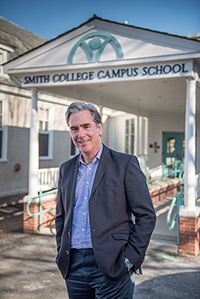Dear Campus School Families,
I have written before about how creative our students are when they are engaged in free play during recess. The small play area right outside my window and next to Gill Hall was modestly renovated this summer. New natural materials – sticks, gravel, sand, rocks, and tree slices – were added to this area, and I couldn’t wait to see how our students would engage with these materials and each other. I can report that much creative play has ensued! Students have used these materials to construct forts, cities, and restaurants (the wood slices were used as plates). They have hammered, stacked, and shoveled. They have combined materials in creative and playful ways. Almost all of this play has been communal in nature.
It does not take much to engage the imagination of a child, and sometimes the simplest of materials are all they need. (Think about when the toddler loses interest in the new toy but is intrigued with the box it came in.) When these materials are from nature students connect with what is real; this adds another important dimension to their play.
When students play and create in this manner they have fun, and this is a powerful enough outcome. But they also learn and develop skills: they negotiate with their playmates, experiment with physics, and think creatively, in addition to many other important skills. As a result, creative play of this sort is one of the most important activities children engage in, and it is why unstructured play time is so important to their development as people and students.
Warmly,
Chris

